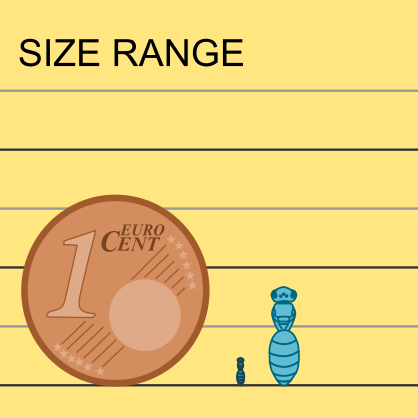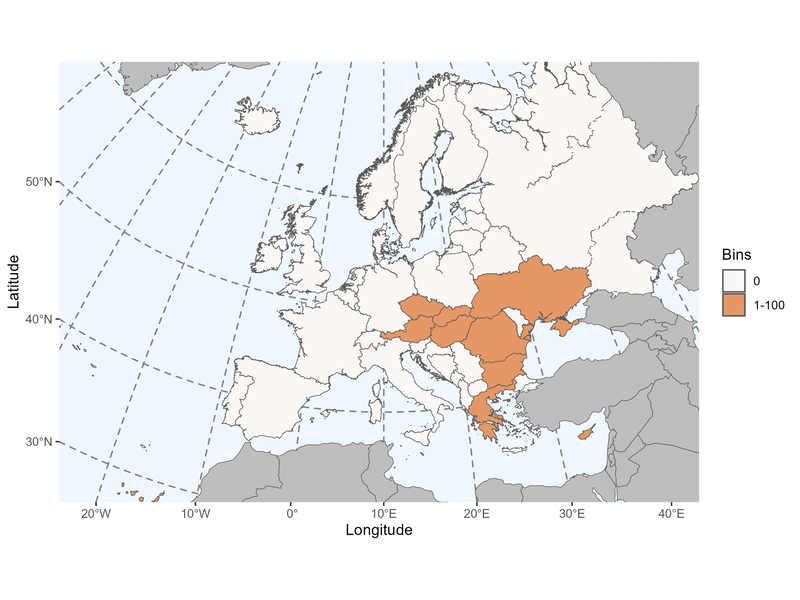Author: Popov, 1932
|
Type species: Phiarus minutus Mocsàry, 1878, by original designation.
|
Clade: Anthophila
Family: Apidae Subfamily: Nomadinae Tribe: Ammobatini |
|
Distinctive traits
|
Pictures of distinctive traits
(Sorry, there is no picture available at this time. If you have some and would like to become a contributor to IDmyBee, please contact us.) |
Morphologically close genera, and how to distinguish them:
Parammobatodes is very similar to Chiasmognathus, and similar to the other Ammobatini.
Chiasmognathus species have mandibles crossing at right angle. They are smaller than 4 mm and lack a jugal lobe at the hindwing.
Ammobates species have mandibles overlapping when closed, and the first recurrent vein joins submarginal cell 2 around the middle of its posterior margin or more basally.
Ammobatoides & Schmiedeknechtia species have an oval or pointed marginal cell, basal part of submarginal cell 1 is around twice as long as that of submarginal cell 2. Males have strongly converging eyes.
Clavipanurgus, Flavipanurgus, Panurginus, Panurgus & Simpanurgus species have a flat clypeus and a short-tongue morphology of mouthparts (short maxillary palpi).
Parammobatodes is very similar to Chiasmognathus, and similar to the other Ammobatini.
- Parammobatodes - Chiasmognathus
Chiasmognathus species have mandibles crossing at right angle. They are smaller than 4 mm and lack a jugal lobe at the hindwing.
- Parammobatodes - Ammobates
Ammobates species have mandibles overlapping when closed, and the first recurrent vein joins submarginal cell 2 around the middle of its posterior margin or more basally.
- Parammobatodes - Ammobatoides & Schmiedeknechtia
Ammobatoides & Schmiedeknechtia species have an oval or pointed marginal cell, basal part of submarginal cell 1 is around twice as long as that of submarginal cell 2. Males have strongly converging eyes.
- Parammobatodes - Clavipanurgus, Flavipanurgus, Panurginus, Panurgus & Simpanurgus
Clavipanurgus, Flavipanurgus, Panurginus, Panurgus & Simpanurgus species have a flat clypeus and a short-tongue morphology of mouthparts (short maxillary palpi).
General comments on Parammobatodes species identification
According to Warncke (1983), the two european species can be distinguished by the flagellum segments and the punctuation of the frons, mesonotum and first metasomal tergum.
According to Warncke (1983), the two european species can be distinguished by the flagellum segments and the punctuation of the frons, mesonotum and first metasomal tergum.
List of the 2 Parammobatodes species found in Europe (Ghisbain et al. 2023)
Parammobatodes maroccanus (Warncke, 1983)
Parammobatodes minutus (Mocsáry, 1878
Species identification:
Parammobatodes maroccanus (Warncke, 1983)
Parammobatodes minutus (Mocsáry, 1878
Species identification:
- P. minutus:
- P. maroccanus:
References with identification keys for some of the species:
- Warncke K., 1983. Zur Kenntnis der Bienengattung Pasites Jurine, 1807, in der Westpaläarktis (Hymenoptera, Apidae, Nomadinae). Entomofauna 4(21): 261-347.
Page contributors:
You noticed a mistake? You have a suggestion to improve this page?
Don't keep it to yourself, contact us and become a contributor to IDmyBee!
References used to write this page:
- Adrien Perrard (Dec. 2023)
- Adrien Perrard (Dec. 2019)
You noticed a mistake? You have a suggestion to improve this page?
Don't keep it to yourself, contact us and become a contributor to IDmyBee!
References used to write this page:
- Ghisbain, G., Rosa, P., Bogusch, P., Flaminio, S., Le Divelec, R., Dorchin, A., Kasparek, M., Kuhlmann, M., Litman, J., Mignot, M., Müller, A., Praz, C., Radchenko, V.G., Rasmont, P., Risch, S., Roberts, S.P.M., Smit, J., Wood, T.J., Michez, D. & Reverte, S. (2023). The new annotated checklist of the wild bees of Europe (Hymenoptera: Anthophila). Zootaxa, 5327(1), 1-147.
- Michener, C.D. 2007. The Bees of the World, 2nd Edition. The John Hopkins University Press, Baltimore.
- Michez D., Rasmont P., Terzo, M., Vereecken, N. 2019. Abeilles d'Europes. Hymenoptères d'Europes, Volume 1. N.A.P. Editions.
- Nieto, A., Roberts, S. P., Kemp, J., Rasmont, P., Kuhlmann, M., García Criado, M., ... & Michez, D. 2014. European red list of bees. Luxembourg: Publication Office of the European Union, 98. (IUCN 2014)
- Rasmont, P., Devalez, Jelle, Pauly, A., Michez, D. & Radchenko, V.G. 2017. Addition to the checklist of IUCN European wild bees (Hymenoptera: Apoidea). Annales de la Société entomologique de France 53: 17-32.
- Warncke K., 1983. Zur Kenntnis der Bienengattung Pasites Jurine, 1807, in der Westpaläarktis (Hymenoptera, Apidae, Nomadinae). Entomofauna 4(21): 261-347.



